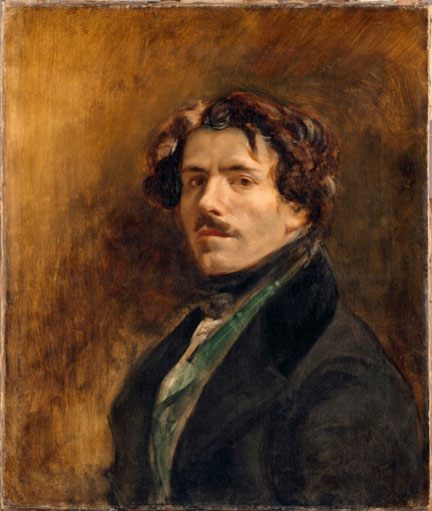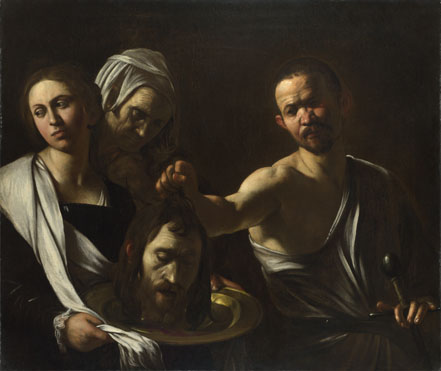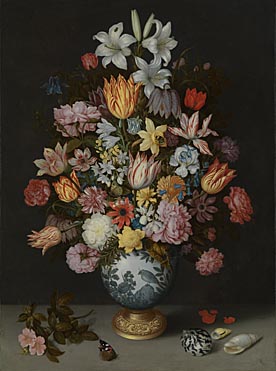SAINSBURY WING
Delacroix and the Rise of Modern Art
17 February – 22 May 2016
Painters' Paintings
From Freud to Van Dyck
23 June – 4 September 2016
Beyond Caravaggio
12 October 2016 – 15 January 2017
SUNLEY ROOM
Visions of Paradise
Botticini's Palmieri Altarpiece
4 November 2015 – 14 February 2016
George Shaw
My Back to Nature
11 May – 30 October 2016
ROOM 1
Dutch Flowers
6 April – 29 August 2016
----------------------------------------------------------------------------------------------------------
DELACROIX AND THE RISE OF MODERN ART
17 February – 22 May 2016
Sainsbury Wing
Admission charge
Described as the last painter of the Grand Style and the first of the modern masters, Eugène Delacroix (1798–1863) was the pre-eminent French artist of the first half of the 19th century – complex, contradictory, a rebel, and an outsider. Few artists had more of a profound and lasting influence on his contemporaries and future generations.

Delacroix was the very engine of revolution that helped transform the art of French painting in the 19th century. Credited with liberating colour and technique from traditional rules and practices, he paved the way for new styles of painting such as Impressionism. Upon his death in 1863, he was the most revered artist in Paris. Baudelaire described the artist as, 'A poet in painting‛ while Cézanne observed, 'We all paint in Delacroix’s language‛. Arguably he was the most influential artist of his era.
This landmark exhibition, the first presentation of Delacroix’s art in Britain for more than 50 years, will explore Delacroix’s influence on his contemporaries, such as Chassériau, Courbet, and Géricault and subsequently the later artists who found inspiration in his art, including Manet, Cézanne, Van Gogh, Gauguin, Renoir, Matisse and Kandinsky.
'Delacroix and the Rise of Modern Art' will include over 60 works borrowed from 30 major public and private collections around the world, including the Musée du Louvre, Musée d’Orsay, and the Petit Palais (Paris); the J. Paul Getty Museum (Los Angeles); the Metropolitan Museum of Art (New York); the National Gallery of Art (Washington); and the Van Gogh Museum (Amsterdam). Works by Delacroix will be displayed alongside works by his contemporaries and later admirers who followed in his footsteps.
A significant number of paintings will come from the National Gallery’s partner for the exhibition – the Minneapolis Institute of Art – where the show was first exhibited.
The paintings will be displayed thematically to explore Delacroix’s work in context and to illustrate his influence in transforming the art of French painting in the 19th century. The themes explored will include: Orientalism; religious, literary and historical narratives; and animals, flowers and aestheticism.
This exhibition is organised by the National Gallery, London and the Minneapolis Institute of Art.
PAINTERS’ PAINTINGS
FROM FREUD TO VAN DYCK
23 June – 4 September 2016
Sainsbury Wing
Admission charge
The National Gallery owns one of the world’s greatest collections of paintings. Among them is a significant group of pictures once owned by fellow painters: Van Dyck’s Titian; Reynolds’s Rembrandt; Matisse’s Degas; Lucian Freud’s Corot. This exhibition looks for the first time at these great works of art from the point of view of their illustrious artistic provenance. They are "painters’ paintings".

Major works in their own right, these paintings are imbued with additional cachet by virtue of their ownership by great painters. They also raise a number of essential questions: What pictures did painters surround themselves with? Did they concentrate on works by their contemporaries or by the great masters of the past? Was their significance emotional, spiritual, or intellectual? How deeply did the paintings impact on their own artistic journeys? And how relevant were they to these painter-collectors’ own work?
To address these issues, the exhibition presents a series of case studies, featuring about 60 works in total. Each section is devoted to a particular painter, including Degas, Lawrence, Reynolds, Matisse, Van Dyck and Freud, and is built around one or several of his "painter's paintings" in the Gallery’s collection. These are supplemented by pictures formerly in the possession of these artists, now borrowed from public and private collections in the UK and abroad. The painters’ collections will be juxtaposed with their own creative works, in order to emphasise the connections between their artistic production and the art they chose to own.
These pairings and confrontations of great works will shed new light on these paintings and the painters who owned them, creating a dynamic and profoundly original dialogue between possession and painterly creation.
BEYOND CARAVAGGIO
12 October 2016 – 15 January 2017
Sainsbury Wing
Admission charge
Beyond Caravaggio will be the first major exhibition in the UK to explore the influence of Caravaggio on the art of his contemporaries and followers.
Michelangelo Merisi da Caravaggio (1571–1610) is one of the most revolutionary figures in art. His strikingly original paintings, with their intense naturalism and dramatic lighting, had a lasting impact on European art, both during his lifetime and in the decades immediately following his untimely death.

This exhibition will look at the ripple effect of Caravaggio’s influence on the art of his followers – artists as diverse as Orazio Gentileschi, Valentin de Boulogne, and Gerrit van Honthorst. Every one of them absorbed something different from Caravaggio – some borrowed his theatrical lighting whilst others sought to emulate the power of his storytelling – and helped propagate his style across Europe, giving rise to the international movement known as ‘Caravaggism’.
This exhibition, which also travels to the National Gallery of Ireland, Dublin, and the Royal Scottish Academy, Edinburgh in 2017, will bring together approximately 50 paintings. With the exception of a select few, which have since gone abroad, the loans come from museums, National Trust houses and private collections throughout the UK. The paintings, many of which will be unfamiliar to audiences, will provide the context for considering Caravaggio; not as a figure in isolation, but as the one at the root of an international artistic phenomenon.
A highlight of the exhibition will be displaying Caravaggio’s 'Supper at Emmaus' (National Gallery, London) alongside his 'Taking of Christ' (on indefinite loan to the National Gallery of Ireland from the Jesuit Community, Leeson St., Dublin). The latter will also be reunited with Giovanni Serodine’s 'Tribute Money' (Scottish National Gallery, Edinburgh) and Antiveduto Gramatica’s 'Christ among the Doctors' (on loan to the Scottish National Gallery from the Archdiocese of St Andrews and Edinburgh) – all paintings acquired in 1802 by Hamilton Nisbet, directly from the illustrious Mattei family; important patrons of Caravaggio.
This exhibition is a collaboration between The National Gallery, London, the National Gallery of Ireland, and the National Galleries of Scotland.
VISIONS OF PARADISE
BOTTICINI’S PALMIERI ALTARPIECE
4 November 2015 – 14 February 2016
Sunley Room
Admission free
This exhibition is the culmination of three years of research on Francesco Botticini’s monumental altarpiece (measuring 228.6 x 377.2cm), The Assumption of the Virgin.

The exhibition will set Botticini’s painting within the context of the traditions of civic humanism and religious patronage in Renaissance Florence. It will explore the life, writings, and political roles of the painting’s patron, Matteo Palmieri (1406–1475), and his relationship with the Medici rulers of Florence.
The altarpiece, completed in about 1477 for Palmieri’s funerary chapel in the church of San Pier Maggiore in Florence, will be displayed alongside 30 works, including paintings, sculpture, drawings, prints, manuscripts, and a bronze medal. The exhibition will explore and clarify the centuries of debate on a variety of aspects of the altarpiece, including its long misattribution to Sandro Botticelli, its controversial iconography, which was deemed heretical by some theologians, and its original location.
The exhibition will also feature the first digital reconstruction of the former church of San Pier Maggiore that was destroyed in the late 18th century. By virtually re-inserting Botticini’s painting into its original architectural and spiritual context, this project will provide new insight into the scale, unusual horizontal format, and iconography of the altarpiece.
GEORGE SHAW
MY BACK TO NATURE
11 May – 30 October 2016
Sunley Room
Admission free
George Shaw became the National Gallery’s ninth Rootstein Hopkins Associate Artist in 2014 and this exhibition is the unveiling of his works created over two years in the studio at the Gallery.

Shaw, who was nominated for the Turner Prize in 2011, is renowned for his highly detailed approach and suburban subject matter. Paintings featuring woodlands have a particular appeal for Shaw as they resonate with his own experience of walking in the forest near his home town as a teenager and the feeling that 'something out of the ordinary could happen at any time there away from the supervision of adults‛.
On accepting the National Gallery’s invitation, he said:
'When I was offered the chance to be the Associate Artist at the National Gallery I couldn’t believe my luck. I first thought how excited I would have been as a teenager to have been given the chance – and how I probably would have wasted it anyway. I still have my Thames and Hudson book on the National Gallery (345 illustrations - 75 in colour) that my mum gave me for a birthday present in the early Eighties.‛
In an idiosyncratic approach, Shaw favours working with Humbrol enamel paints (typically used to paint model trains and aeroplanes), lending his work a unique appearance.
DUTCH FLOWERS
6 April – 29 August 2016
Room 1
Admission free
The first display of its kind in 20 years, this exhibition will explore the development of Dutch flower painting from its beginnings in the early 17th century to its blossoming in the late 18th century.

Coinciding with the flower shows at Chelsea and Hampton Court, 'Dutch Flowers' will draw connections between the development of flower painting in the Netherlands to increased interest in botany, horticulture, and the phenomenon of ‘tulip mania’.
The exhibition will present an overview of the key artists active within the field and highlight the connections between them. Viewers will be invited to examine each work closely and in detail to appreciate the stylistic and technical characteristics of each artist.
Works from the National Gallery Collection will be displayed alongside long-term loans from private collectors. The exhibition will include a major recent acquisition, Ambrosius Bosschaert the Elder’s A Still Life of Flowers in a Wan-Li Vase, acquired in 2010.
CONTACT
For further information please contact the National Gallery Press Office on 020 7747 2865 or press@ng-london.org.uk
Publicity images can be obtained from http://press.ng-london.org.uk
